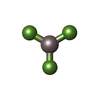Entry Database : PDB / ID : 9bhqTitle Crystal structure of KRAS G12A in a transition state mimetic complex with CYPA and RMC-7977 Isoform 2B of GTPase KRas Peptidyl-prolyl cis-trans isomerase A Keywords / Function / homology Function Domain/homology Component
/ / / / / / / / / / / / / / / / / / / / / / / / / / / / / / / / / / / / / / / / / / / / / / / / / / / / / / / / / / / / / / / / / / / / / / / / / / / / / / / / / / / / / / / / / / / / / / / / / / / / / / / / / / / / / / / / / / / / / / / / / / / / / / / / / / / / / Biological species Homo sapiens (human)Method / / / Resolution : 1.9 Å Authors Pourfarjam, Y. / Goldgur, Y. / Cuevas-Navarro, A. / Lito, P. Funding support Organization Grant number Country National Institutes of Health/National Cancer Institute (NIH/NCI)
Journal : Nature / Year : 2025Title : Pharmacological restoration of GTP hydrolysis by mutant RAS.Authors : Cuevas-Navarro, A. / Pourfarjam, Y. / Hu, F. / Rodriguez, D.J. / Vides, A. / Sang, B. / Fan, S. / Goldgur, Y. / de Stanchina, E. / Lito, P. History Deposition Apr 21, 2024 Deposition site / Processing site Revision 1.0 Nov 6, 2024 Provider / Type Revision 1.1 Jan 29, 2025 Group / Category / citation_authorItem _citation.country / _citation.journal_abbrev ... _citation.country / _citation.journal_abbrev / _citation.journal_id_ASTM / _citation.journal_id_CSD / _citation.journal_id_ISSN / _citation.journal_volume / _citation.page_first / _citation.page_last / _citation.pdbx_database_id_DOI / _citation.pdbx_database_id_PubMed / _citation.title / _citation.year
Show all Show less
 Yorodumi
Yorodumi Open data
Open data Basic information
Basic information Components
Components Keywords
Keywords Function and homology information
Function and homology information Homo sapiens (human)
Homo sapiens (human) X-RAY DIFFRACTION /
X-RAY DIFFRACTION /  SYNCHROTRON /
SYNCHROTRON /  MOLECULAR REPLACEMENT / Resolution: 1.9 Å
MOLECULAR REPLACEMENT / Resolution: 1.9 Å  Authors
Authors United States, 1items
United States, 1items  Citation
Citation Journal: Nature / Year: 2025
Journal: Nature / Year: 2025 Structure visualization
Structure visualization Molmil
Molmil Jmol/JSmol
Jmol/JSmol Downloads & links
Downloads & links Download
Download 9bhq.cif.gz
9bhq.cif.gz PDBx/mmCIF format
PDBx/mmCIF format pdb9bhq.ent.gz
pdb9bhq.ent.gz PDB format
PDB format 9bhq.json.gz
9bhq.json.gz PDBx/mmJSON format
PDBx/mmJSON format Other downloads
Other downloads 9bhq_validation.pdf.gz
9bhq_validation.pdf.gz wwPDB validaton report
wwPDB validaton report 9bhq_full_validation.pdf.gz
9bhq_full_validation.pdf.gz 9bhq_validation.xml.gz
9bhq_validation.xml.gz 9bhq_validation.cif.gz
9bhq_validation.cif.gz https://data.pdbj.org/pub/pdb/validation_reports/bh/9bhq
https://data.pdbj.org/pub/pdb/validation_reports/bh/9bhq ftp://data.pdbj.org/pub/pdb/validation_reports/bh/9bhq
ftp://data.pdbj.org/pub/pdb/validation_reports/bh/9bhq




 F&H Search
F&H Search Links
Links Assembly
Assembly
 Components
Components Homo sapiens (human) / Gene: PPIA, CYPA / Production host:
Homo sapiens (human) / Gene: PPIA, CYPA / Production host: 
 Homo sapiens (human) / Gene: KRAS, KRAS2, RASK2 / Production host:
Homo sapiens (human) / Gene: KRAS, KRAS2, RASK2 / Production host: 







 X-RAY DIFFRACTION / Number of used crystals: 1
X-RAY DIFFRACTION / Number of used crystals: 1  Sample preparation
Sample preparation SYNCHROTRON / Site:
SYNCHROTRON / Site:  NSLS-II
NSLS-II  / Beamline: 17-ID-2 / Wavelength: 0.978 Å
/ Beamline: 17-ID-2 / Wavelength: 0.978 Å Processing
Processing MOLECULAR REPLACEMENT / Resolution: 1.9→29.81 Å / SU ML: 0.21 / Cross valid method: FREE R-VALUE / σ(F): 1.34 / Phase error: 23.28 / Stereochemistry target values: ML
MOLECULAR REPLACEMENT / Resolution: 1.9→29.81 Å / SU ML: 0.21 / Cross valid method: FREE R-VALUE / σ(F): 1.34 / Phase error: 23.28 / Stereochemistry target values: ML Movie
Movie Controller
Controller


 PDBj
PDBj





























